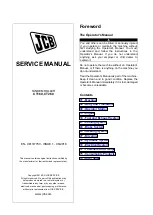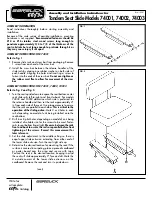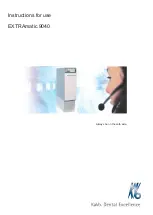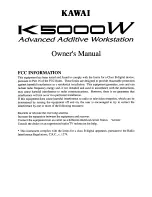
Safety and operating instructions
© Construction Tools PC AB | 3390 5211 01 | 2020-09-18
Original Instructions
9
2.6 Carrier, precautions
WARNING
Falling carrier
If the load-bearing capacity of the carrier used is insuffi-
cient, the carrier will not be stable. It can topple over and
cause injuries and damage.
Using a carrier whose load-bearing capacity is too high
will greatly burden the hydraulic attachment causing it to
wear faster.
u
Only attach the hydraulic attachment to a hydraulic
carrier of a suitable load-bearing capacity.
u
The carrier must remain stable at all times.
u
Read the carrier manufacturer's Safety and operating
Instructions before attaching the hydraulic attach-
ment to the carrier and operating it. Observe all in-
structions.
2.7 Transport, precautions
WARNING
Risk of death due to suspended loads
When lifting loads these can swing out and fall. This can
result in serious injuries or even death.
u
Never stand underneath or in the swinging range of
suspended loads.
u
Only move loads under supervision.
u
Only use approved lifting equipment and lifting gear
with sufficient load bearing capacity.
u
Do not use worn lifting gear (ropes, belts, chains,
shackles etc.).
u
Do not place lifting gear such as ropes and belts on
sharp edges or corners, do not knot these or twist
them.
u
When leaving the workplace, set down the load.
WARNING
Injury due to swivelling load
When transporting the load by crane it can swivel and
cause severe injuries and considerable damage to prop-
erty.
u
Ensure that no personnel, objects or obstacles are
located in the swivel range of the load.
2.8 Hydraulic installation,
precautions
WARNING
Hydraulic pressure too high
If the hydraulic pressure is too high, the parts of the hy-
draulic attachment will be exposed to excessively high
loads. Parts can break loose or burst causing serious in-
juries.
u
Lay the drain line of the pressure relief valve directly
in the tank to ensure the safe functioning of the pres-
sure relief valve!
u
The pressure relief valve must be set at the maxi-
mum static pressure.
u
The pressure relief valve setting must be checked to
ensure that the maximum static pressure (see chap-
ter
Technical specifications
) of the hydraulic instal-
lation is not exceeded at any time. Attach a lead seal
to the pressure relief valve.
u
Prior to their first use, the safety facilities on the hy-
draulic installation must be checked by a profes-
sional/authorised monitoring body for their quality
(CE mark etc.), suitability and proper functioning.
u
If any significant changes are made to the hydraulic
installation, a new acceptance inspection is to be
carried out in accordance with the relevant national
safety provisions.
WARNING
Hot hydraulic oil squirting out
The hydraulic system is under high pressure. Hydraulic
lines may spring a leak or burst. Hydraulic oil squirting
out can lead to serious injury.
u
When attaching the hydraulic attachment do not lay
any hydraulic lines through the carrier's cab.
u
Only use hydraulic lines which comply with the fol-
lowing quality requirements:
- For the function open and close
- Hydraulic hoses with 4 reinforcement steel wires
according to DIN EN 856 4SH,
- Hydraulic pipes, seamless cold-drawn steel pipes
according to DIN EN 10305
- For the function turn
- Hydraulic hoses with 2 steel plaitings according to
DIN EN 853 2SN,
- Hydraulic pipes, seamless cold-drawn steel pipes
according to DIN EN 10305.










































